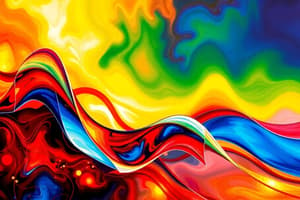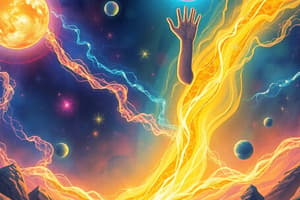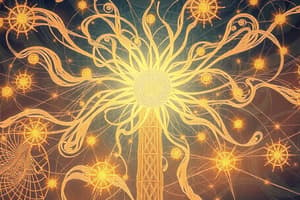Podcast
Questions and Answers
What is the law that states that energy cannot be created or destroyed, only converted?
What is the law that states that energy cannot be created or destroyed, only converted?
- Law of Motion
- Law of Conservation of Mass
- Law of Conservation of Energy (correct)
- Law of Gravity
The nucleus is the powerhouse of the cell where energy is produced.
The nucleus is the powerhouse of the cell where energy is produced.
False (B)
What is the process by which cells produce energy from glucose?
What is the process by which cells produce energy from glucose?
Respiration
The density of an object is calculated by dividing its __________ by its __________.
The density of an object is calculated by dividing its __________ by its __________.
What type of chemical reaction involves the combination of two or more substances to form a new substance?
What type of chemical reaction involves the combination of two or more substances to form a new substance?
Match the following types of forces with their descriptions:
Match the following types of forces with their descriptions:
Mitochondria are the control centers of the cell where DNA is stored.
Mitochondria are the control centers of the cell where DNA is stored.
What is the process by which plants produce energy from sunlight?
What is the process by which plants produce energy from sunlight?
The cell membrane is a __________ membrane that surrounds the cell.
The cell membrane is a __________ membrane that surrounds the cell.
What is the state of matter characterized by particles that are close together and have a fixed shape?
What is the state of matter characterized by particles that are close together and have a fixed shape?
Study Notes
Physical Sciences
- Matter and its Properties:
- Matter can exist in three states: solid, liquid, and gas
- Characteristics of matter: mass, volume, density, and buoyancy
- Density: mass per unit volume (density = mass / volume)
- Energy and its Forms:
- Types of energy: kinetic, potential, thermal, electrical, and chemical
- Energy transformations: conversion from one form to another
- Law of Conservation of Energy: energy cannot be created or destroyed, only converted
Chemical Reactions
- Types of Chemical Reactions:
- Combination reaction: two or more substances combine to form a new substance
- Decomposition reaction: a single substance breaks down into two or more substances
- Displacement reaction: one element displaces another element from a compound
- Neutralization reaction: acid and base react to form salt and water
- Chemical Equation:
- Representation of a chemical reaction using symbols and formulas
- Reactants: substances that react to form products
- Products: substances formed as a result of the reaction
- Chemical Reaction Rates:
- Factors affecting reaction rates: concentration, temperature, surface area, and catalysts
Cell Biology
- Cell Structure:
- Cell membrane: semi-permeable membrane that surrounds the cell
- Cytoplasm: jelly-like substance inside the cell membrane
- Nucleus: control center of the cell where DNA is stored
- Mitochondria: powerhouses of the cell where energy is produced
- Cell Functions:
- Photosynthesis: process by which plants produce energy from sunlight
- Respiration: process by which cells produce energy from glucose
- Cell division: process by which cells reproduce and grow
Forces and Motion
- Types of Forces:
- Contact forces: push or pull forces that act through physical contact
- Non-contact forces: forces that act without physical contact (e.g. gravity, magnetism)
- Newton's Laws of Motion:
- First law: an object at rest will remain at rest, and an object in motion will continue to move with a constant velocity, unless acted upon by an external force
- Second law: force is equal to the mass of an object multiplied by its acceleration (F = ma)
- Third law: every action has an equal and opposite reaction
- Motion:
- Types of motion: linear, circular, and rotational motion
- Distance and displacement: distance is the total path traveled, while displacement is the shortest distance between two points
Matter and its Properties
- Matter exists in three states: solid, liquid, and gas
- Characteristics of matter include mass, volume, density, and buoyancy
- Density is calculated by dividing mass by volume (density = mass / volume)
Energy and its Forms
- Energy types include kinetic, potential, thermal, electrical, and chemical
- Energy can be transformed from one form to another
- The Law of Conservation of Energy states that energy cannot be created or destroyed, only converted
Chemical Reactions
Types of Chemical Reactions
- Combination reactions involve two or more substances combining to form a new substance
- Decomposition reactions involve a single substance breaking down into two or more substances
- Displacement reactions involve one element displacing another element from a compound
- Neutralization reactions involve acid and base reacting to form salt and water
Chemical Equation
- Chemical equations represent chemical reactions using symbols and formulas
- Reactants are substances that react to form products
- Products are substances formed as a result of the reaction
Chemical Reaction Rates
- Factors affecting reaction rates include concentration, temperature, surface area, and catalysts
Cell Biology
Cell Structure
- The cell membrane is a semi-permeable membrane surrounding the cell
- Cytoplasm is the jelly-like substance inside the cell membrane
- The nucleus is the control center of the cell where DNA is stored
- Mitochondria are the powerhouses of the cell where energy is produced
Cell Functions
- Photosynthesis is the process by which plants produce energy from sunlight
- Respiration is the process by which cells produce energy from glucose
- Cell division is the process by which cells reproduce and grow
Forces and Motion
Types of Forces
- Contact forces are push or pull forces that act through physical contact
- Non-contact forces are forces that act without physical contact (e.g. gravity, magnetism)
Newton's Laws of Motion
- The First Law states that an object at rest will remain at rest, and an object in motion will continue to move with a constant velocity, unless acted upon by an external force
- The Second Law states that force is equal to the mass of an object multiplied by its acceleration (F = ma)
- The Third Law states that every action has an equal and opposite reaction
Motion
- Types of motion include linear, circular, and rotational motion
- Distance is the total path traveled, while displacement is the shortest distance between two points
Studying That Suits You
Use AI to generate personalized quizzes and flashcards to suit your learning preferences.
Description
Quiz about the properties of matter and different forms of energy, including kinetic, potential, and thermal energy, with a focus on density and energy transformations.




